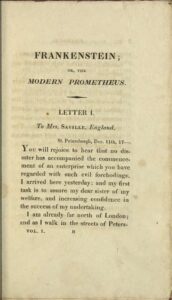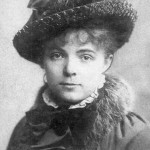
Mary Shelley’s grim fantasy, “Frankenstein Or The Modern Promethius” – to quote its full title – was published on New Year’s Day 1818. It has rarely been out of print in one form or another since.
This first edition carried a preface by the poet, Percy Bysshe Shelley. In its early days, there were those who asserted that the poet had written the entire book. Some of this confusion may have been because male readers did not expect females to write horror.
Perhaps they could not believe that a young woman could create such an horrific story It must be by Shelley himself! Anyone who has had the misfortune to read Percy Shelley’s Gothic novel, ‘Zastrossi’, will long have held such a notion to be preposterous.
Mary’s novel is dedicated to her father. He is the once famed William Godwin, a philosopher. Godwin also wrote novels, the darkest and most effective of which is ‘Caleb Williams’ (1794); it depicts a murky, lawless England. We sometimes find, or imagine we find, echoes of ‘Caleb Williams’ within the pages of his teenage daughter’s writing, Mary Wollstonecraft Godwin was in bed when she drowsily awoke to see, in her own words, ‘the pale student of unhallowed arts kneeling beside the thing he had put together.
Typically, her idea hatched itself from that productive hypnoid state between sleeping and waking. In Mary’s day, the term ‘hypnoid’ had yet to be coined, but it’s certainly a very curious state of mind when the old, original grey matter of the brain attempts without language, but with pictures, to communicate with the newer white matter in the fore -brain. A hypnoid state briefly prevails. Mary Shelley is not alone in enjoying that particular form of inspiration.
No matter if she, in her generation, knew nothing of such hypnoid states, or of such dangers as asepsis. The proliferation of micro-organisma within the body had yet to be studied. Some similar form of sickness may have been the cause of death of Mary Wollstonecraft (who had been another and engaging writer), mother of baby Mary when the latter was newly born.
It can hardly be a surprise when the author born of a mother who died at her birth figures in a violently misanthropic tale as a man with no father… My history of science fiction is ‘Billion Year Spree’ (later, at a publishers insistence, to become ‘Trillion Year Spree’ with David Wingrove’s co-operation). When ‘Billion’ was launched, there were people eager to claim old so-and-so as the Father of science fiction. I would have none of it; I proclaimed Mary Shelley to be Mother of Science Fiction. Although this caused some bad blood at the time, happily it has been spilt and mopped up long ago.
After her triumph, almost immediately performed on stage, Mary later wrote another futurist novel, ‘The Last Man’. More than a horror tale; it has a mythic quality. ‘The Last Man’ was published in 3 volumes early in 1826. Mary of course is now no teenager. Various personae take on the mantles of Percy Shelley and Byron. who are both dead and gone. The first volume, it must be said, is somewhat confused and dull; matters improve once plague spreads and dire events and foreboding interpenetrate the text.
We are asked, for instance, ‘What are we, the inhabitants of this globe, least among the many peoples that inhabit infinite space? Our minds embrace infinity. The visible mechanism of our being is subject to merest accident.’
Where ‘Frankenstein’ ends in gloom – you may recall its final sentence, “He was soon borne away by the waves and lost in darkness and distance” – the conclusion of ‘the Last Man’ is relatively cheerful, where our last man ails on, down the Mediterranean, under – and I quote – “the ever-open eye of the Supreme”.
We may remember that Thomas Campbell wrote a poem also called “The Last Man”. John Martin, that strange artist, paints the scene with a similar theme of solitude.
Such misgivings were prompted by news of a plague emanating from Calcutta – really the Capital of all Diseases, I’d say. Anyway, the plague advanced eastwards towards Teheran and Basra where the bodies of the dead were too numerous to bury. It also spread towards the vast hunting grounds of China. Its name was cholera.
A second pandemic followed. It spread from Moscow, along the Danube; it affected a million people in Hungary. Krakow fell. Warsaw, Riga.. In 1831, the plague crossed the seas to Sunderland, and from there-on to Scotland and London.
So this final novel of Mary Shelley’s is prodromic – speaking out as a warning against evils that might befall.
Another aspect remains ever vivid, pervading all editions of ‘Frankenstein’. The creature has a negligent father and no mother. Mary had a negligent father and no mother. Hence, the creature’s cry, reversing Christian doctrine: “I am malicious because I am miserable.”
It is that pervasive sense of loss which bestows on the creature its puissance, and provides the force that propels this notorious story along. Mary did indeed speak, as she says, ‘to the mysterious fears of our nature’.
Mary Shelley died, as did the artist J. M. W. Turner, in 1851 – the year of the Great Exhibition. One may stand in silence by her grave in Bournemouth now, within sound of the sea.





